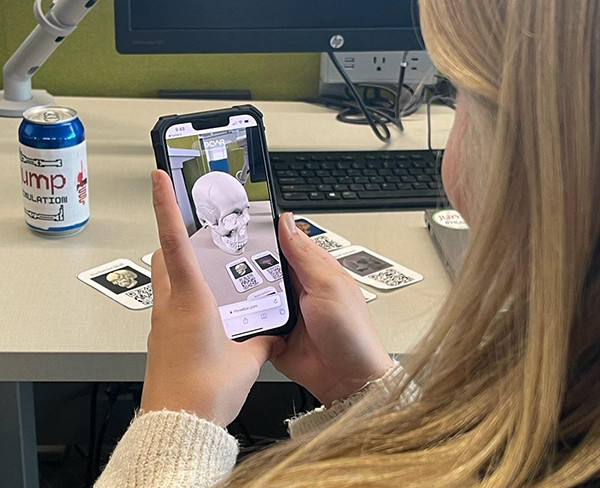
AR_STEAM image
November 8 is National STEAM Day – a day that inspires kids to explore and pursue their interests in Science, Technology, Engineering, Art and Math. But OSF HealthCare is making a point to celebrate and promote OSF STEAM learning throughout the month of November.
Noël Adams, vice president, Academic Collaborations and operations, OSF Innovation Labs at OSF HealthCare says the STEAM lab will mark National Steam Day by kicking off the first of a series of augmented reality (AR) lessons for its Anatomy Academy.
Adams explains students can access a free lesson by registering on the OSF STEAM website and they’ll receive a series of QR codes to scan with their mobile phone or tablet to trigger digital images via augmented reality that can put a trainer in the child’s hand.
“As we go through and we teach different modalities or different trainers or different human anatomy, we can change whatever it is that child is holding just through the QR code. And so, it really equalizes our ability to, not only teach remotely because we can put a trainer in any kid’s hand anywhere, but also there’s no cost barrier in our training.”
This live course on systems of the body will run once a month for the next year. The curriculum was developed by OSF Innovation engineers and faculty at the University of Illinois for
6th-12th grades. Adams thinks it could be a great option for home schooled kids whose parents might not be experts in anatomy.
“There’s not a lot out there for homeschool kids as far as health care curriculum and STEAM so we did make a strategic effort to create something that’s very welcoming to them. So, these courses actually run during the day when they would have traditional schooling and again on-demand if they want to do their schooling at night.”
A recorded version of the live lesson will also be available on the OSF STEAM website.
Throughout November, OSF HealthCare will be hosting school children at Jump Trading Simulation & Education Center in Peoria where they can learn about careers such as medical visualization and bioengineering. Innovation engineers will also be traveling to schools. For example, in Pontiac, Illinois, students will get a DIY lesson detailing how to make their own anatomage table for less than $50. The device uses advanced 3D anatomy visualization to teach lessons about the body.
The engineers will also mark National STEAM Day by leading hands-on STEAM activities for hospitalized kids and their siblings at OSF HealthCare Children’s Hospital of Illinois. Throughout the year, OSF provides free bedside STEAM programs so children can stay engaged in learning while they’re out of school due to their illness.
The range of OSF STEAM programs cover grade school through college and include simple, free online activities and at-home courses that come with activity kits. There are mini-med classes for college-age students to explore various aspects of medicine plus internships that focus on creating STEAM activities.
Community Partnerships
OSF is bringing STEAM education to as many young people as possible, particularly those who are under-represented in fields related to Science, Technology, Engineering, Art and Math, including women and people of color. According to the National Science Foundation (PDF) and the National Academies, women and certain ethnic groups –Blacks, Hispanics, and American Indians – are considered underrepresented in STEAM.
Community partnerships are an important way to reach under-represented groups and introduce young people to ideas and experiences that can create an “ah hah” moment, where they discover a passion for health care. Peoria’s Friendship House President and CEO Marcellus Sommerville says plenty of young people have lit up with ideas after participating in a STEAM activity, such as a baby shark dissection led by OSF STEAM educators who came on-site to guide the effort.
“I mean, we’ve had experiences where kids have said they want to be a biochemist, and they’re really excited; they see themselves as you know, dissecting and explaining and exploring. For each kid, it allows him to dream of what possibilities are there for them.”
Sommerville says as many as 40 young people from Friendship House also spent time over one week, learning about career options by exploring the various labs and technology at Jump.
“They got to touch the manikins, they got to see how the blood flowed and all the different things I mean, for that week, they were overjoyed. So, I think that’s the fun part about the partnership – exposing these kids to bigger and better things that they necessarily would not see or did not know.”
The Anatomy Academy augmented reality lessons will generate excitement, Sommerville says, because with only a smartphone, kids will get a more immersive experience. In that way, easy technology can be an equalizer
as Sommerville sees it.
“I think it could offset and help the kids who maybe don’t have those opportunities to have a laptop at home or bigger devices, but most kids have a mobile phone and if they can use it in a proper way, it can be a huge benefit.”
Sommerville is also grateful to donors to the OSF STEAM program because, he says, they’re investing in the community and helping kids dream of how they can join the medical workforce of the future.
